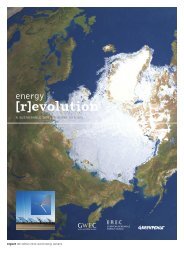download the mexico energy revolution scenario
download the mexico energy revolution scenario
download the mexico energy revolution scenario
You also want an ePaper? Increase the reach of your titles
YUMPU automatically turns print PDFs into web optimized ePapers that Google loves.
WORLD ENERGY [R]EVOLUTION<br />
A SUSTAINABLE ENERGY OUTLOOK<br />
9<br />
climate & <strong>energy</strong> policy | TARGETS AND ACTION<br />
Governments should mandate <strong>the</strong> phase-out of incandescent and<br />
inefficient light bulbs and replace <strong>the</strong>m with <strong>the</strong> most efficient<br />
lighting. Countries like Cuba, Venezuela and Australia have already<br />
banned incandescent light bulbs.<br />
Governments should also set emissions standards for cars and<br />
power plants, such as those proposed in Europe for passenger cars<br />
of 120g CO2 /km and 350 g/kWh for power plants. Similar<br />
emissions standards, as already implemented in China, Japan and<br />
<strong>the</strong> states of Washington and California, will support innovation and<br />
ensure that inefficient vehicles and power plants are outlawed.<br />
Action: Support innovation in <strong>energy</strong> efficiency, low carbon<br />
transport systems and renewable <strong>energy</strong> production<br />
Innovation will play an important role in making <strong>the</strong> Energy<br />
[R]evolution happen, and is needed to realise <strong>the</strong> ambition of everimproving<br />
efficiency and emissions standards. Programmes<br />
supporting renewable <strong>energy</strong> and <strong>energy</strong> efficiency development and<br />
diffusion are a traditional focus of <strong>energy</strong> and environmental<br />
policies because <strong>energy</strong> innovations face barriers all along <strong>the</strong><br />
<strong>energy</strong> supply chain (from R&D to demonstration projects to<br />
widespread deployment). Direct government support through a<br />
variety of fiscal instruments, such as tax incentives, is vital to<br />
hasten deployment of radically new technologies due to a lack of<br />
industry investment. This suggests that <strong>the</strong>re is a role for <strong>the</strong> public<br />
sector in increasing investment directly and in correcting market<br />
and regulatory obstacles that inhibit investment in new technology<br />
Governments need to invest in research and development for more<br />
efficient appliances and building techniques, in new forms of<br />
insulation, in new types of renewable <strong>energy</strong> production (such as<br />
tidal and wave power) as well as in a low carbon transport future,<br />
through <strong>the</strong> development of better batteries for plug-in electric cars<br />
or fuels for aviation from renewable sources. Governments need to<br />
engage in innovation <strong>the</strong>mselves, both through publicly funded<br />
research and by supporting private research and development.<br />
There are numerous ways to support innovation. The most<br />
important policies are those that reduce <strong>the</strong> cost of research and<br />
development, such as tax incentives, staff subsidies or project<br />
grants. Financial support for research and development on ‘dead<br />
end’ <strong>energy</strong> solutions such as nuclear fusion should be diverted to<br />
supporting renewable <strong>energy</strong>, <strong>energy</strong> efficiency and decentralised<br />
<strong>energy</strong> solutions.<br />
Specific proposals for efficiency and innovation measures include:<br />
appliances and lighting<br />
Two types of renewable quota systems have been employed -<br />
tendering systems and green certificate systems.<br />
• Efficiency standards Governments should set ambitious, stringent<br />
and mandatory efficiency standards for all <strong>energy</strong> consuming<br />
appliances that constantly respond to technical innovation and<br />
enforce <strong>the</strong> phase-out of <strong>the</strong> most inefficient appliances. These<br />
standards should allow <strong>the</strong> banning of inefficient products from <strong>the</strong><br />
market, with penalties for non-compliance.<br />
• Consumer awareness Governments should inform consumers<br />
and/or set up systems that compel retailers and manufacturers to<br />
do so, about <strong>the</strong> <strong>energy</strong> efficiency of <strong>the</strong> products <strong>the</strong>y use and<br />
buy, including awareness-raising and educational programmes.<br />
Consumers often make <strong>the</strong>ir choices based on non-financial<br />
factors but lack <strong>the</strong> necessary information.<br />
• Energy labelling Labels provide <strong>the</strong> means to inform consumers<br />
of <strong>the</strong> product’s relative or absolute performance and <strong>energy</strong><br />
operating costs. Governments should support <strong>the</strong> development of<br />
endorsement and comparison labels for electrical appliances.<br />
buildings<br />
• Residential and commercial building codes Governments should<br />
set mandatory building codes that require <strong>the</strong> use of a set share of<br />
renewable <strong>energy</strong> for heating and cooling and compliance with a<br />
limited annual <strong>energy</strong> consumption level. These codes should be<br />
regularly upgraded in order to make use of fresh products on <strong>the</strong><br />
market and non-compliance should be penalised.<br />
• Financial incentives Given that investment costs are often a<br />
barrier to implementing <strong>energy</strong> efficiency measures, in particular<br />
for retrofitting renewable <strong>energy</strong> options, governments should<br />
offer financial incentives including tax reductions schemes,<br />
investment subsidies and preferential loans.<br />
• Energy intermediaries and audit programmes Governments<br />
should develop strategies and programmes to promote <strong>the</strong><br />
education of architects, engineers and o<strong>the</strong>r professionals in <strong>the</strong><br />
building sector as well as end-users about <strong>energy</strong> efficiency<br />
opportunities in new and existing buildings. As part of this<br />
strategy governments should invest in ‘<strong>energy</strong> intermediaries’ and<br />
<strong>energy</strong> audit programmes in order to assist professionals and<br />
consumers in identifying opportunities for improving <strong>the</strong><br />
efficiency of <strong>the</strong>ir buildings.<br />
transport<br />
• Emissions standards Governments should regulate <strong>the</strong> efficiency<br />
of private cars and o<strong>the</strong>r transport vehicles in order to push<br />
manufacturers to reduce emissions through downsizing, design and<br />
technology improvement. Improvements in efficiency will reduce<br />
CO2 emissions irrespective of <strong>the</strong> fuel used. After this fur<strong>the</strong>r<br />
reductions could be achieved by using low-emission fuels. Emissions<br />
standards should provide for an average reduction of 5g<br />
CO2/km/year in industrialised countries. These standards need to be<br />
mandatory. To dissuade car makers from overpowering high end<br />
cars a maximum CO2 emissions limit for individual car models<br />
should be introduced.<br />
• Electric vehicles Governments should develop incentives to<br />
promote <strong>the</strong> fur<strong>the</strong>r development of electric cars and o<strong>the</strong>r<br />
efficient and sustainable low carbon transport technologies.<br />
Linking electric cars to a renewable <strong>energy</strong> grid is <strong>the</strong> best<br />
possible option to reduce emissions from <strong>the</strong> transport sector.<br />
• Transport demand management Governments should invest in<br />
developing, improving and promoting low emission transport<br />
options, such as public and non-motorised transport, freight<br />
transport management programmes, teleworking and more<br />
efficient land use planning in order to limit journeys.<br />
1<br />
104



![Energy [R]evolution - European Commission](https://img.yumpu.com/49109324/1/184x260/energy-revolution-european-commission.jpg?quality=85)


![5905 gp [eu rev]csfr4.qxd - Energy [R]evolution](https://img.yumpu.com/42305023/1/184x260/5905-gp-eu-revcsfr4qxd-energy-revolution.jpg?quality=85)


![5905 gp [eu rev]csfr4.qxd - Energy [R]evolution](https://img.yumpu.com/28729264/1/184x260/5905-gp-eu-revcsfr4qxd-energy-revolution.jpg?quality=85)